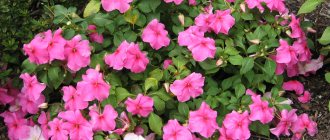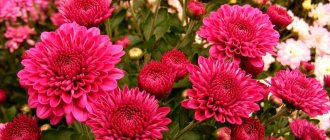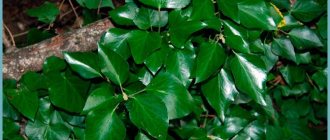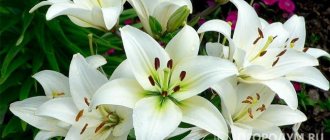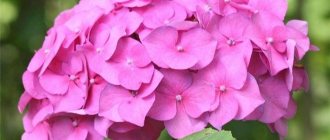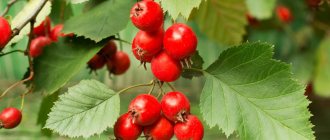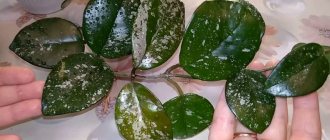The herbaceous plant poppy (Papaver) is a member of the Poppy family. This genus includes more than 100 species. The homeland of this plant is considered to be Southern and Central Europe, Australia and Asia. Poppies are naturally found in regions with temperate, subtropical and cold climates. They also prefer to grow in dry places, for example, in deserts, steppes, semi-deserts, and also on rocky and dry slopes. This flower is cultivated as an ornamental and medicinal plant. In a number of countries, poppy cultivation is prohibited, since most of its species contain narcotic substances. In some countries, poppies are grown on an industrial scale to produce opium, which is extracted from unripe pods. Opium is used as a raw material for the production of painkillers and sleeping pills.
Already in Ancient Rome it was known that poppy had healing properties; at that time, opium, or more precisely, its hypnotic effect, was studied. There is information that the scientific name of this plant was derived from the Latin word “papa”, translated as “father”, this was explained by the fact that to calm a restless crying child, poppy seeds were added to his food.
In the Muslim countries of Asia Minor in the Middle Ages, the consumption of alcohol was prohibited; instead, opium was smoked there. Over time, this tradition became widespread in eastern countries, and today China is the largest consumer of opium. The Chinese government in 1820 introduced a ban on the import of intoxicating poison, but after some time, when the “opium” war with England was lost, the import of opium was again allowed. The fact is that England had enormous profits from the supply of this product to China. Today, the cultivation of soporific poppy is carried out in India, Asia Minor and Central Asia, China and Afghanistan. And decorative poppies, as well as their hybrids, are popular among gardeners. This plant can often be seen in rock gardens or flower beds.
Poppy plant: photos, types, cultivation, planting and care in open ground
admin 03.11.2017 534 View
The range of life forms of these brightly flowering favorites of rural front gardens and rock gardens includes both fast-growing annuals and powerful perennial herbs. Most poppies prefer full sun and well-drained soil. They are great for informal, nature-style gardens and filling voids in herbaceous mixed borders.
Poppy
Recommended species and varieties
Alpinum hort. (M. alpine)
White, yellow, orange and orange-pink brushes up to 4 cm in diameter bloom from late spring to mid-summer (if fading ones are removed immediately). This graceful evergreen perennial forms small, dense rosettes and is short-lived. It is often grown as an annual and easily propagates by self-sowing. The leaves are gray or gray-green, finely pinnately dissected. The bolls are small, barrel-shaped, bristly. The height and diameter of the plant is 20x20 cm.
Small dense sockets
“Alba” (syn. f. album)
The variety has white flowers with a mass of yellow stamens.
White flowers
"Summer Breeze"
An example of first generation (F1) hybrids with a magnificent array of flowers rising above dense gray foliage in various shades of red, orange, yellow and white.
Atlanticum (M. atlantic, M. moroccan)
The dull orange saucer-shaped flowers, about 6 cm in diameter, appear on stiff, branched stems from late spring to late summer. The deeply dissected rough leaves of this evergreen perennial are mainly collected in a basal rosette. The capsule is club-shaped, smooth. In gardens, the species reproduces by self-sowing. The height and diameter of the plant is 50x50 cm.
Saucer-shaped flowers
"Flore Pleno"
The variety has semi-double flowers.
Semi-double flowers
"Double Orange"
The flowers are semi-double or double with colors ranging from brick-red to tangerine.
"Double Orange"
P. bracteatum
In mid-summer, this annual produces bright scarlet flowers 6-9 cm in diameter with a large black spot in the center of each petal. The leaves are fleshy, bristly, deeply dissected.
Bright scarlet flowers
Нeldreichii
Small fiery orange flowers with a diameter of 5 cm bloom in late spring - early summer. A rhizomatous herbaceous perennial growing in clumps with lanceolate, unequally toothed leaves. The height and diameter of the plant is 50x50 cm. This species is quite rare in gardens, where it is represented mainly by the “Fireball” variety (syn. “Nanum”, P. orientale “Flore Pleno”), only 30 cm high with double orange flowers.
Small fiery orange flowers
P. miyabeanum (M. Miyabe)
Creamy yellow flowers
P. nudicaule (M. holostem, M. icelandic)
Cup-shaped bright yellow, orange or red flowers with a diameter of 4-6 cm bloom in late spring - early summer (for autumn sowing) or in mid-late summer (for spring sowing). An annual or short-lived perennial with a basal rosette of yellowish or grayish-green deeply dissected leaves. The capsule is club-shaped, oblong, bristly. The height and diameter of the plant is 45x45 cm. The varieties are mainly large-flowered, with a corolla diameter of up to 12.5 cm.
Cup-shaped bright yellow inflorescences
“Aurora Borealis”
The color of the variety varies from white to yellow, orange, orange-pink and red.
“Aurora Borealis”
Champagne Bubbles
Poppies of the group are up to 40 cm high with flowers of various shades of red and yellow.
Champagne Bubbles
Garden Gnome (Gartenzwerg)
The group includes dwarf varieties up to 30 cm high with even more diverse flowers - white, yellow, orange, orange-pink, red.
Dwarf varieties
"Kelmscott Giant"
The poppy variety has a height of about 80 cm and flowers in pastel shades.
Pastel flowers
"Oregon Rainbows"
The flowers are single or semi-double, up to 18 cm in diameter, in different shades of white, yellow and red, including bicolor and bordered, with a darker or lighter edge.
Non-double flowers
"San Remo"
The variety produces non-double, mostly yellow, orange or red corollas.
"San Remo"
“Unwins Giant Coonara”
Plants up to 50 cm high with flowers of the same color.
Source
The varieties of perennial poppies that are most popular among gardeners are the red varieties
Money tree - what it looks like, can it be kept at home?
Gardeners have some varieties of papaver that are very successful. Most often this is due to the decorative nature of the flowers or their ease of care.
Beauty Queen
The flowers are red-orange, cup-shaped. The petals are silky. It blooms at the end of May and fades at the end of June. The variety reaches a height of 1 m. One plant has several peduncles.
Beauty Queen variety
Curlilocks
The flowers are orange-red, up to 16 cm in diameter. The petals of this perennial frost-resistant variety resemble a fringe. At the base of each of them is a dark spot. Blooms in June. The bush reaches 70 cm in height.
Variety Curlylox
Nana Allegro
It has large semi-double orange-red flowers. Each petal has a black spot at the base. Flowering period is June and July. The bush will stretch no more than 50 cm.
Oriental poppy Allegro
Garden Glory
Another fringed variety with 15 cm flowers. The petals are coral-colored with a burgundy stroke at the base. The core is dark. Blooms for 2-3 weeks at the beginning of summer.
Variety Garden Glory
Popscile
A small variety of saffron poppy up to 25 cm high. The flowers are large, up to 10 cm, red-orange.
Cardinal
Another subspecies of saffron papaver. It received its name for its similarity in color to the cardinal's robe. Flower diameter – 6 cm. Bush height – 40 cm.
Papaver Cardinal
Poppy - planting, growing and care
Poppy is a herbaceous plant . It can be either annual or perennial. Belongs to the poppy family. There are about 100 species in nature. The flowers are solitary, located on a high stem. They can reach a height of 90 cm. The leaves are serrated. They change in size from narrow to wide in the direction from bottom to top. The root system goes deep into the soil. When transplanted, it is difficult to take root in a new place. Flower colors are red, pink, white and purple. There are rare varieties of poppy with a blue color. The diameter of the flower can reach 20 cm. Before the bud opens, the stem straightens. After flowering, it produces fruits in the form of a box.
Which family does it belong to?
Poppy belongs to the Poppy family of the same name – Papaveraceae. Papavers (from Latin Papaver - poppy) are the closest relatives of buttercups. The poppy family includes both annual and perennial plants. Among the most famous representatives of Poppy species are corydalis, celandine, and eschscholzia. There are about 700 species in total.
Decorative poppy
Briefly about the history of appearance
According to scientists, poppy is a plant known to mankind back in the Neolithic period (X-III millennium BC). Poppy seeds are found during excavations of sites of ancient people and in Egyptian pyramids.
There are many legends about poppy and its origin. According to ancient Roman mythology, poppies grew where the tears of the goddess Venus, who lost her lover, the beautiful Adonis, fell to the ground. Not only among the Greeks, but also among other peoples, poppies are flowers of love and passion.
According to Greek myth, these flowers were created to comfort the goddess Demeter, who had lost her daughter. Having collected an armful of scarlet flowers, the inconsolable mother plunged into oblivion.
Interesting! Ukrainian legends say that this red flower grows where Cossack blood was spilled on the ground. For many peoples, red poppies are also a symbol of fallen warriors.
Plant characteristics
In nature, poppies are common in temperate and subtropical climate zones. Their favorite places to grow are rocky mountain slopes, steppes and semi-deserts. In Russia, it is found in the Rostov region and Krasnodar region, in the Caucasus, Stavropol region, Altai, as well as in Central Asia and Eastern Siberia. Most often you can find the holostem and eastern varieties, as well as the self-sowing plant.
Wild poppies
For your information! Among the variety of papavers, there are both annual species and perennials.
So, what does a poppy look like? The flowers of this plant are single, large and bright, on long peduncles and with numerous stamens. The leaf is always pinnately dissected, pubescent or smooth, depending on the subspecies. Poppy fruits are in the form of dense capsules with small seeds. These flowers are pollinated by bees, but some species have switched to self-pollination. When the capsule suddenly bursts, light seeds scatter in all directions and are carried further by the wind.
Benefits and harms
Poppy seeds have many beneficial properties:
- They contain calcium, zinc, copper, phosphorus, sulfur, iron, magnesium and manganese, which are so valuable for the human body.
- Helps against insomnia and depression (especially in combination with honey).
- Have a beneficial effect on the gastrointestinal tract. They are especially effective against diarrhea.
- Relieves coughing attacks.
- Slows down the development of cancer cells.
Poppy decoction easily relieves headaches and toothaches, but is quickly addictive. And in general, experts do not recommend self-medication; even folk remedies should be taken after consultation and under the supervision of a doctor.
Note! It is not advisable to consume poppy seeds for elderly people, children under 3 years of age, pregnant and lactating women, as well as alcoholics and patients with liver and lung diseases.
The main harm of papaver is that the powerful drug opium is obtained from its milky juice.
Poppy propagation
Poppies easily propagate by self-sowing. Due to the characteristics of the tap root, they do not tolerate transplantation well. Their seeds (annual and perennial) are sown in open ground in a permanent place in early spring. It has very small seeds. Therefore, before sowing, it is advisable to soak them in water and mix them with sand. And then sow to a depth of about 1 cm. After the seedlings appear (usually after 8-10 days), they need to be thinned out, leaving 10-20 cm between them.
Growing poppies
In general, poppy is an unpretentious plant. But it does not tolerate transplantation well. Therefore, it is better to immediately plant it in a permanent place. It loves sun but can tolerate some shade. Does not tolerate stagnant water, loves fertile soil. It can grow in one place for about 10 years.
Inexperienced gardeners, often thinking that it has died after flowering, plant other plants in its place, thereby damaging the fragile root system.
Poppy care
It does not require special care. Often tolerates severe drought. Does not tolerate moisture stagnation well. Harvesting fruit pods that have set helps prolong flowering. Dried leaves and stems must be cut off. To control weeds, it is better to mulch the soil around the poppy. When the foliage turns yellow and the box is completely dry, it is time to collect the seeds.
Types and varieties of poppy
Among perennial crops, oriental poppy (Papaver orientale) is often found. A very decorative flower of different colors. Unfortunately, this species is prohibited from growing in Russia (due to its content of oripavine, which is included in the official list of narcotic drugs). Growing oriental poppies can result in administrative and even criminal liability.
Soporific poppy (P. somniferum L.). Also prohibited from cultivation. Reaches a height of 120-140 cm. The flowers are large, with a diameter of 13 cm or more, they can be simple or double, white, pink, orange, red, lilac, purple, violet. It blooms profusely and spectacularly in late June - in July. Its flowers bloom early in the morning and fall off in the evening.
Meconopsis (Blue/Himalayan poppy). This genus includes about 50 species and belongs to the Poppy family. It has different colors, but the most popular are the types with dark blue and light blue flowers. The Himalayas are considered their homeland. It can reach a height of 1 m. Unlike the usual specimen, its stamens are yellow rather than black. The flower size in diameter can reach 10 cm.
Poppy pests
Among the pests, it is worth noting the bean aphid, which leads to leaf curling and death. She appears in June.
Poppies are also susceptible to powdery mildew. Sick plants are stunted and lose their decorative properties.
Bronze beetles eat the stamens and petals of flowers, and also damage leaves and stems. As a result of such an attack, the buds do not bloom and the leaves wither.
Also dangerous is the spider mite, which sucks the juice from the leaves in hot weather.
Share the link with your friends:
Please rate the article:
(votes: 65 )
Source
Use in landscape design
In landscape design, poppies can also be planted near moisture-loving plants, such as large-leaved hydrangea (hydrangea macrophylla).
Other tips:
- Red or black varieties will perfectly set off the snow-white inflorescences of hydrangia.
- If you want to create a piece of a summer field on your site, then you need to add cereals (for example, feather grass) to the papaver, as well as the natural neighbors of poppies - cornflowers and daisies.
- Red poppies look great against the backdrop of bright green thuja and juniper needles.
- With the help of poppies you can create a “rustic” style in your area.
Papaver is also planted on alpine hills. Simple varieties in white, yellow or red-orange look especially good here.
Alpine slide
This representative of the flora quickly loses its decorative effect, so it is better to “disguise” it with other plants.
Legends and origin story
There are many beautiful legends telling about the origin of a passionate flower with delicate velvet petals that can put you to sleep.
One of them says that when God created the earth, water, flora and fauna, everything turned out very beautiful. But under the cover of night these beauties were hidden. Night tried to open them for its hour with the help of the stars, but this attempt was unsuccessful. And then God decided to help the Night and created the Sleep and its dreams.
Many gods are depicted decorated with poppies. The goddess of earthly fertility, Persephone, is depicted wrapped in intertwined poppy flowers. The Greek god of dreams and reveries Hypnos (among the Romans - Morpheus) is depicted holding poppy heads in his hands or crowned with a wreath of these flowers. On the head of the God of Death Thanatos - a young man with black wings, wearing black clothes - also rests a wreath of poppy flowers. And this is not a complete list.
It is obvious that this seemingly simple flower is capable of making an impression. It entered the history and religion of different countries and many peoples due to its ability to induce sleep.
Preparation and storage
Poppy petals are picked by hand during flowering, dried under ventilated canopies, spread in a thin layer of 1-2 cm on paper or fabric. Pack in bags and store in dry, dark places. Poppy flower (photo in the section below) is used to treat cough.
The sleeping pill is grown on industrial plantations, which are strictly guarded. Harvested using combines after the capsules are completely ripe. Dried under sheds, used for medical preparations containing opium.
General characteristics of the plant
The poppy root system is fragile, so the plant reacts very poorly to transplantation. But if you still need to replant it, then you need to wait until spring or the end of summer.
The plant attracts attention with its amazingly beautiful flowers, similar to a fire bowl with black coals in its middle. Large flowers with rich, delicate petals, bathed in dew, and countless stamens in the center, open with the first rays of the sun. Their petals are painted scarlet, snow-white, pinkish, golden and even black in all possible shades.
Harm and contraindications
It is not recommended to self-medicate with drugs or infusions made independently based on poppy seeds. This can be done after consulting a doctor or under his supervision. You cannot use the seeds of the plant for diseases such as asthma, alcohol addiction, gallstone pathologies, and emphysema. Poppy is also contraindicated for constipation; it can worsen it.
Children under 2 years of age and elderly people are not recommended to eat confectionery products with poppy seeds.
Annual species
One of the easiest plants to grow and care for is annual poppies. They have one highlight - a fragrant aroma.
Opium poppy
Among the most worthy varieties of sleeping pills, or opium poppy, are:
Varieties of self-seeding
A type of annual poppy that is very popular among flower growers, the self-sown or wild field poppy (Papaver rhoeas) grows up to 100 cm in height. Under natural conditions, its small inflorescences can be either simple or semi-double, with satin petals of the traditional scarlet color and black middle. But under cultural conditions of growth, self-seeded poppy inflorescences are found in peach, rich orange, delicate cream shades or glamorous pink.
Among the most attractive varieties of self-seeded poppy are:
It should be noted that self-seeding is a controversial annual. Plants that produce late shoots can overwinter at the rosette stage.
But some perennial poppies can demonstrate very uncertain properties.
Holostalked species
Among the most beautiful varieties of hollow-stem poppy are:
The species Gray and Peacock are also grown as annual poppies.
Care, soil, watering
As for care, the most important thing here is nutritious garden soil, rich in minerals. The place should be sunny; in the shade the plant withers and does not bloom. Watering is not required, as poppies prefer to grow on dry, stony or rocky soils with good drainage.
After the decorative poppy has faded, you can cut off the peduncle, perhaps if there is no sharp cold snap and with enough light the poppy will bloom again. Please note that if you are growing an annual of an exclusive variety, you must maintain isolation from other types of poppy, since after self-sowing the plant will not have the same characteristics.
Perennial species
poppy
Among the interesting varieties of poppy, one can highlight the variety Tangerite Parfait with semi-double inflorescences that appear continuously, one after another, throughout the summer period, subject to constant timely plucking of dried flowers. Particularly vigorous flowering occurs in early summer.
Eastern view
There are garden varieties with double and semi-double flowers. The period when poppies of this species bloom is limited to only 12-15 days from late May to early June.
Among the interesting varieties of oriental poppy are:
Flower growers also love the varieties Garden Glory, Mrs. Perry, Caryn, Pettis Plum and many other varieties.
Such types of perennial poppy as Alpine, Amur, white-pink, Scandinavian and a number of other charmingly beautiful, although less decorative varieties, compared to oriental poppy, are also cultivated.
When and how does it bloom
Flowers come in the shape of a saucer or bowl, simple, double (peony-shaped) or semi-double. The petals are usually round, corrugated or fringed. Poppies begin to bloom in late May - early June. Sometimes flowering occurs in July and the first ten days of August. During the period of active flowering, you can feed with complex mineral fertilizers. Annual poppies are removed after flowering.
Note! To prolong flowering, seed pods need to be trimmed. Again, self-seeding will not occur.
Care and reproduction
Sow seeds mixed with sifted sand before winter or early spring directly into the soil. It is important to choose a sunny area for sowing, since poppy flowers lose their brightness in shaded areas. After the emergence of seedlings, they must be thinned out, leaving 10-20 cm between plants.
The propagation method by seeds for perennial poppy species is slightly different from the propagation method for annual poppy species. Seeds are sown for seedlings in special boxes immediately after they are collected, and with the appearance of 1-2 true leaves, they are planted in special peat pots, which are subsequently dug into the ground.
Some perennial varieties of poppies at the age of 3-4 years can be propagated by dividing the bush. This procedure is carried out only after waiting for the end of flowering.
Poppies do not tolerate transplantation well, which is due to the structural features of the plant's root system. The strongly recessed tap root of the poppy cannot be dug up without damaging it. Therefore, the vegetative propagation method of poppy is rarely used.
In hot and dry summers, it is recommended to systematically remove dried leaves of the plant.
Diseases and pests
Leaf infection with powdery mildew
The main problem for poppies is fungal diseases. The most common fungal diseases of poppies are powdery mildew, downy mildew and fusarium.
With powdery mildew, the leaves become covered with a white coating, similar to a cobweb. After it disappears, you can notice the bodies of the fungi in the form of black small spots. Powdery mildew significantly inhibits plant growth and prevents the formation of flowers and fruits.
Poppy sneaker
The fight against it is carried out by spraying poppy leaves with solutions of the following compositions: 40 g of copper chloroxide in 10 liters of water or 50 g of soda in 10 liters of water.
With peronosporosis, the leaves become covered with spots of a red-brown hue and are significantly deformed. In addition, curvature of the stems and peduncles occurs. At the next stage of infection, fungal bodies appear on the leaves in the form of purple spots. At the same time, the plant’s growth slows down, and the size of flowers and fruit pods decreases significantly.
Countering downy mildew is carried out similarly to combating powdery mildew.
Fusarium is the most unpleasant poppy disease. With it, the leaves turn black, and the entire bush begins to dry out, since the entire vascular system of the plant is affected. It is impossible to cure this disease, so the infected plant must be immediately removed and destroyed, and the place where it grew should be treated with some kind of fungicide.
There are relatively few pests that can attack poppy. Most often, plants are attacked by weevils or poppy secretive proboscis. Both pests in adult form damage the root system of the plant, and the larvae of the secretive proboscis also feed on its leaves.
Poppy sneaker
Pest control consists of preventive treatment of the soil before planting with Bazudin or Chlorophos. Application rates are usually indicated on the packaging of the drugs. If pests are found on plants, they should be treated three times with Chlorophos solution. The break between treatments is 10 days. When processing, do not allow the insecticide to come into contact with poppy flowers and fruits.
Conclusion
Poppies are unpretentious and beautiful flowers that can enliven any garden. They look great both as a monoplant in flower beds and in a group with other plants. The agricultural technology of poppies is very simple and even novice gardeners can grow them.
Useful and harmful properties
The harm of poppy is due to its unreasonable use by the person himself. This magical flower serves as the basis for the production of opiates, the excessive use of which leads to drug addiction, destroying the human psyche and bringing terrible suffering to the addict.
Poppy seeds are widely used in cooking as additives in baked goods and a wide variety of sweets and cookies. At the same time, the beneficial properties of poppy seeds are completely preserved provided that they are properly collected and dried without any trace of narcotic substances in them.
The leaves, roots and stems of the plant are used only in medicine . They are not eaten.
Source
It's no secret that the red flowers found in the middle of the wheat fields are poppies. This plant is very attractive, and its density of growth adds scale to the overall appearance. For some time now you can get such beauty in your own garden.
Landing options
You should know that the semantic completeness of the composition depends on the correct design of the planting of shrubs, if these plants are planted to mark the boundaries of your garden design ideas (Figure 2). But it happens the other way around, when an ornamental shrub is the center of the composition, and it is surrounded by other plants, for example, flowers. A properly laid foundation of the garden, in the form of trees and bushes, guarantees its longevity, because on an already formed background you can successfully create various compositions, changing or adding details in the form of plant or architectural elements. To do this, you must initially choose the right plants for the base, that is, compare not only their appearance, but also their physical characteristics (height, crown shape, leaf color). And, of course, the correct placement of plants in the garden.
The location of the plant on the lawn, flower garden, or next to it will be unusual. Original ideas also include planting in so-called modules, that is, placing plants in specially designated places. Another beautiful design idea is to arrange plants using bouquet planting.
Figure 2. Options for placing ornamental shrubs in the garden
Quite often, shrubs are supplemented with annual and perennial flowers, cereals, and various decorative elements. In addition, they are wonderful decorators, because if positioned correctly, they can hide the problems of the garden, and also help to visually enlarge the boundaries of the garden area. They are successfully used to create hedges. Qualified garden design specialists know the rule well: no matter what style your garden is designed in, the surrounding nature should be reflected in it, as in a mirror.
Details
Flower buds have a regular shape and are filled with many thin stamens on powerful peduncles. Buds can appear either single or collected in paniculate inflorescences. Red poppies are most common, but white, pink, orange or yellow flowers can also be seen. The seed capsule is club-shaped, containing a large number of seeds inside. After they are completely ripe, it opens and the seeds scatter over fairly large distances, maintaining their germination capacity for 4 years.
Characteristics of annual garden poppies
Soporific or opium poppy is presented in the form of many varieties, among which two of the most beautiful can be distinguished:
White and yellow papavers
Combined with poppies in shades of scarlet, purple and pink, they create stunning floral arrangements.
Black & White
A variety of oriental perennial poppy. The flowers are milky white, with a dark ring around the core. The stamens are dark gray. The height of the peduncle is up to 60 cm. The flowering period is from June to July.
Black and White variety
Blue Moon
A very spectacular annual variety that is rarely found on sale. Height is approximately 60-65 cm. Each white petal has a stroke of blue-violet color. The flowers themselves are large, up to 20 cm.
Variety Blue Moon
Sulfureum
A lemon-yellow variety of saffron poppy. Does not exceed 30 cm in height. Flowers with a diameter of 5-6 cm.
Atlant
The Atlant variety is most similar to wild representatives of the poppy family. The bush does not exceed 20 cm in size. White or yellow flowers are small, up to 5 cm.
Rules for planting and further care of annual queens
Planting and propagation
All annual varieties of garden poppies have an unpretentious disposition. Thanks to the natural process of propagation by self-seeding, this plant may not be removed from one area for many years. Annual poppies do not require special care; this plant can do without additional watering or fertilizers. If you want to create suitable conditions, you can periodically add organic and mineral complexes in the form of solutions, which will make the plant even more decorative. In this case, the bushes can become much more luxuriant, and the buds can be neater and brighter.
Annual poppies have a sufficient number of qualities that make them valued by gardeners. This plant can be sown in the voids between perennials and ornamental shrubs that have not yet grown. Until they come into full force, these places will be filled with bright red flowers. Growing poppies in such conditions is very profitable because most of the weeds will be eliminated naturally.
Propagation of annual poppies
All annual varieties reproduce by seeds. They are sown before winter or early spring, immediately in a permanent place. You can also use peat pots to propagate seedlings.
Important! It is best to use peat pots as a container for growing seedlings, because the root system of annuals does not tolerate the transplantation procedure very well.
If you need to collect soporific poppy seeds, you do not need to wait for the seed pods to fully ripen, which attracts some species of birds to the garden plot. For successful collection, it is best to pull suitable specimens out of the ground and place them upside down in paper bags, leaving them in a dark, ventilated room until fully ripe.
Complete characteristics of perennial poppy varieties
Perennial poppy is a plant with a rather spectacular appearance, reaching a height of 1 meter. During flowering, large buds form on the bushes, the value of which lies in early flowering, when most plant crops are just beginning to grow green mass.
Among the most popular types are:
Interesting! One of the most widely used varieties of the Atlant poppy, its height is 20 cm, and single yellow and white flowers appear on small bushes. Flowering that begins in June can last up to 2 months if certain conditions are met.
In order to be able to sow poppy seeds, they must be collected. This is quite simple to do; you need to wait until they are completely dry, then cut them and store them in a thick paper or fabric bag. Seeds can be stored in boxes on stems, or poured into a glass or cardboard container.
Perennial varieties bloom the following year when sown in autumn. If you do not collect the seeds on the site, the boxes will open on their own and scatter over fairly long distances. In this case, some of the seeds will remain in the same place, and they will germinate next year.
Planting poppies in open ground
The steps of agricultural technology look like this:
It is important not to over-moisten the soil so that all the seeds do not go to great depths, otherwise it will be very difficult for them to germinate.
Further cultivation of poppies in open ground
Ornamental varieties of poppy are fairly unpretentious plants that tolerate light frosts. They can grow both in sunny areas and in slight shade, and caring for them is not difficult at all if favorable conditions are created.
Perennial garden poppies respond well to replanting, which is best done in the fall during periods of frequent rain. To ensure that the root system remains intact, poppies are transplanted together with a ball of earth.
When regularly digging up the soil during the active growing season, you should take into account the parameters of the root system, which goes to a sufficient depth. It is necessary to dig up the soil at least 30 cm, and you can add additional humus or compost using 5 kg per 1 sq. m. m.
Initially, planting should be done at an acceptable distance, so that there is a distance of 50-70 cm between adult specimens.
Further care consists of creating a mulching layer of peat or sawdust. Mineral fertilizing is carried out during the growth of green mass and during the budding period using mineral complexes.
Caring for the plant involves timely pruning of yellowed leaves and dried stems. This is especially necessary to do if further seed collection is not planned. By winter, the above-ground part of the plant is cut off to the very base. Despite their cold resistance, young bushes can be covered with a mulch layer using spruce branches, sawdust or dry leaves.
Transplanting decorative poppies and methods of propagation
Perennial varieties of garden poppies reach large sizes in 5 years, after which they can be propagated. To do this, it is not necessary to remove the plant from the soil; just carefully cut off part of the rhizome with the tip of a shovel.
The root system of the plant, despite its size, is very fragile, so it is best to separate the lateral roots. The most suitable time for this is the end of spring, when flowering has not yet begun. To ensure that the minimum number of young roots is damaged, it is better to separate some of them together with a lump of earth.
The main difficulties of growing ornamental poppies in open ground
Most of the reasons leading to poor health of the plant are unfavorable weather conditions.
Downy mildew is a fungal disease that causes brown spots and distorted shoots. Prevention of this disease is carried out using fungicidal drugs.
Fusarium can be identified by the presence of dark spots on both stems and leaves. The diseased plant begins to dry out and then dies. This disease cannot be treated due to damage to the entire vascular system of the plant crop. After removing the affected bush, the soil is treated with fungicidal preparations.
Interesting! Insects on the poppy may include weevils or secretive proboscis. For prevention, seeds are treated with special preparations before sowing, and the plant itself can be sprayed with a weak solution of Chlorophos.
Choosing a landing site
It is worth taking a responsible approach to resolving this issue, since the oriental poppy is very sensitive to transplantation, like all other tap-root perennial flowers. Therefore, you will have to plant the poppy in a permanent place and expect a decorative effect no earlier than after 2 or even 3 years, but it will amaze with its beauty and size of flowers for about 7 years, after which it is advisable to renew the bush.
You will need to take care in advance about temporarily replacing the long-lived plant with some kind of annual, since after flowering, only the root system of the poppy remains viable, and the shoots will dry out completely. When choosing an annual crop, you need to know that early poppy varieties bloom in May-June, and late ones in June-July.
It is preferable to plant the bush in sunny places, although it will grow well in shaded areas. The perennial grows well on sandy soil; stones in the soil will not be an obstacle either.
